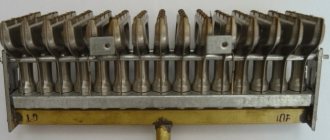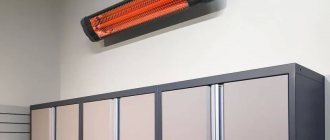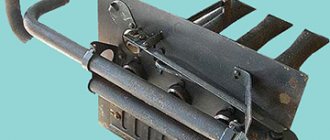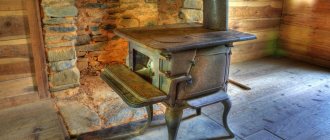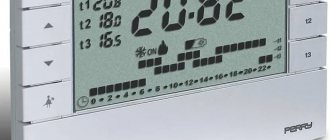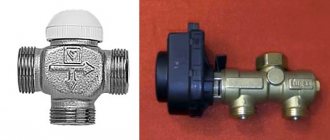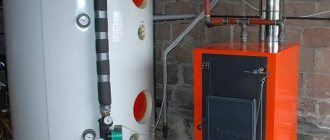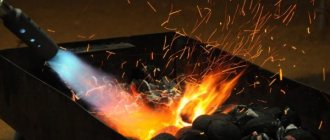The burner of a gas boiler converts the chemical energy of the fuel into the thermal energy of water, which is supplied to the heating and hot water supply system of the house. Gas burners for heating stoves are installed in special devices called boilers. The correct choice of burner device will ensure not only a comfortable living environment in the house, but also its safety.
Purpose and advantages of nozzles
Gas burners (or nozzles) are designed to operate the stove on gas. Like other similar devices, the nozzle mixes fuel - natural or liquefied gas with air. As a result, the temperature in the oven increases.
Most often, such gas products are installed in baths , where high temperatures are required for a long time. However, nothing prevents you from installing a nozzle in your home in order to save yourself from the usual methods of kindling. In addition, such products have a number of significant advantages:
- Safety. Since such products work with explosive material, they are subject to strict requirements regarding reliability. You can verify this by reading the quality certificate.
- Availability of automation. Most gas products are equipped with automatic temperature control , which provides not only economical fuel consumption, but also protection from overheating or explosion of the furnace.
- Economical. As you know, gas is much cheaper than the cost of firewood, coal or electricity.
- Variety of fuels used. Many devices can operate on natural or liquefied gas.
- Ease of operation. The operation of gas devices for furnaces does not require any specific skills. In addition, some models can be operated from a special remote control.
- Ergonomics. Storing coal, firewood or other flammable materials requires a lot of space. The supply of fuel to the injector comes from the gas column.
Trouble-shooting
Having a boiler at home brings many advantages, but it also has a number of disadvantages, and the user does not always know what to do correctly. Boiler faults are common to many types. It is important to promptly determine the cause of these faults before calling emergency services. List of the most common and most likely faults.
First of all, if the boiler does not start, you need to check the circuit components:
- network voltage;
- faulty boiler fan switch or motor;
- damaged boiler cables;
- false triggering contacts of automation or commissioning equipment;
- availability of water, whether the gas boiler is powered to the minimum required level specified by the equipment manufacturer.
If the boiler failure is not caused by any of these problems, the following procedure:
- Pay attention to the noises made by the boiler, because they are often the first witnesses of destruction. They can also be due to hot water trapped inside the firebox or due to the presence of air in the heating system due to clogged air ducts.
- Pipe rupture. It usually occurs due to problems with a jammed boiler feed valve, various scale-forming deposits in the boiler, or a malfunction of the condensate drainage systems.
- Failures due to exceeding the pressure and temperature readings, their corresponding sensors can trigger, for example, due to a broken thermometer or, conversely, which is especially dangerous as a result of real overheating of the boiler.
- The heating circuits are not working, possibly due to poor quality of feed water and scale formation in the boiler pipes.
- A problem occurs with the burner (flame breaks, gas accumulation causes detonation and explosion).
Principle of operation
There are 2 types of such devices on the gas burner market:
Atmospheric nozzles draw air from the room where the stove is located. In addition, the operation does not require the use of complex automation. Thanks to this, the product has a simpler and more uncomplicated design. The main drawback is the requirement for good air circulation. Therefore, atmospheric burners should be installed in well-ventilated areas. However, some models have special sensors that monitor the oxygen level and, if its content is low, turn off the gas supply.
Supercharged products are equipped with complex automation , due to which they have a more complex design. Such products operate on the principle of forced air injection. Fans are responsible for this, regulating the pressure and volume of supplied oxygen. The main requirement for use is that air must be taken from the street.
Photos in the text to illustrate what was said
Atmospheric gas burner for furnace
Atmospheric nozzle with flame dividers
Gas burner with nozzle and power adjustment
Blast gas burners with nozzle
Turbocharged air injectors
Type of fuel used
Everything is much simpler here - the device can run only on gas or use several types of fuel. The first option is the simplest type of gas injectors and is the most popular in comparison with its “competitor”. As a rule, such products are installed in houses or apartments where there is a gas supply.
The second option has a more complex design, but can work with several types of fuel:
- liquefied gas;
- natural gas;
- diesel fuel.
Of course, the cost of such varieties is higher. Therefore, they are more often purchased in cases where gasification of the house is planned in the near future.
Application area of LPG
Due to its environmental friendliness (clean combustion) and relatively low production and processing costs, propane-butane gas is widely used for the industrial and economic needs of the population. The scope of application of liquefied petroleum gas is wide. For example, LPG is used as a source of heat, fuel for vehicles, raw materials for the production of aerosols, etc.
The use of LPG as a raw material for home heating retains all the advantages of autonomous heating using natural main gas, with the exception of current gas costs. But it often happens that even with a relatively close location of the main gas pipeline, the prospect of connecting to the “cherished pipe” remains far beyond the horizon. In this case, you should approach the choice of fuel with a calculator. For example, let’s consider heating a 300 m2 cottage with three types of fuel: liquid (diesel) (DT), mains electricity and LPG. On average, such a room consumes 80,000 kW of energy per year for heating. Based on this figure, we will make the following calculations:
Table 1. Economic comparison of heating costs for a cottage with an area of 300 m2
| Options | Electricity | DT | LPG |
| Fuel consumption per year, kWh | 80 000 | 80 000 | 80 000 |
| Fuel cost, rub./l | — | 25 | 15 |
| Thermal energy, kW/l | — | 11.6 (37.7 MJ/kg) | 7.2 (46.3 MJ/kg) |
| Cost, rub./kWh | 2.66 (with electric plates) | 2,15 | 1,53 |
| Costs per year, rub. | 212 800 | 172 000 | 122 400 |
Prices are valid for June 2011. Average gas consumption is 0.86 kg per 10 kW.
The presented table for estimating fuel consumption and costs shows a clear feasibility study for the use of LPG. Additional advantages of bottled gas, in contrast to diesel fuel and electricity, will be: the ability to organize various options for preparing hot water (boiler or flow-through heat exchanger) and minimal emissions into the atmosphere, unlike diesel fuel. Only NOХ, CO2 and steam will be emitted with flue gases. When using condensing boilers as heat generators, harmful emissions are reduced significantly, and gas savings can reach 30%!
Important points when choosing a nozzle
Sales consultants can help you choose a gas burner. But as you know, rely on others, but don’t make a mistake yourself. Therefore, it is recommended that you familiarize yourself with a number of points before purchasing.
- Features of the premises. First of all, this is the area. If it is less than 12 sq. m., then it would be more reasonable to buy a supercharged type, if larger - atmospheric. Ventilation also plays an important role. If the speed and volume of air circulation leaves much to be desired, it is worth purchasing a forced-air gas burner.
- Oven type. If the stove runs only on gas, you need to purchase an atmospheric version. In other cases, the supercharged variety is perfect.
- Power. The expression “the higher the power, the better” does not apply here. This value should be calculated based on the area of the room. So, for 10 sq. m. requires 1 kW of energy.
- Manufacturer country. When choosing gas equipment, you should remember that foreign products are of higher quality and more durable than domestic ones. Therefore, first of all, it is recommended to pay attention to American, German and Italian injectors.
Purchasing a gas injector will first of all help strengthen your financial situation, and only then free you from constant running around with firewood or coal. A gas stove is a very convenient and practical invention , but you must remember about the explosiveness of this fuel. Therefore, you should not purchase the cheapest and low-quality products.
Why is it prohibited to use gas nozzles in furnaces? These kinds of questions have been regularly coming from visitors to EnergoVOPROS.ru over the past few months. Gas workers are demanding that the burners be dismantled and full-fledged gas boilers installed. Why is this happening? Have there been any changes in legislation? We are publishing clarifications on this matter, which were given by gas workers of the Republic of Bashkortostan.
Gas workers prohibit using a stove with a gas burner (nozzle). Why?
The Public Electronic Newspaper (published in Bashkiria) received an appeal from residents of the village of Arslanovo, Buzdyak district of the republic. They reported that representatives of the gas service of the Buzdyak district are now carrying out repair work in the village. And they demand that all residents who still have brick stoves with a gas burner (nozzles) installed inside, immediately demolish these stoves. Otherwise they threaten to not connect the gas heating. Residents do not understand what law or document this requirement is based on, since this is not explained to them.
These journalists forwarded their questions to the local gas supply organization Gazprom Gas Distribution Ufa. A company representative said the following in response to an inquiry:
— The populated areas of the Buzdyaksky district were supplied with gas by collective and state farms in the 80-90s of the last century. And to do this quickly, they installed gas burners on existing wood stoves. They simply installed a burner without automation. And now this equipment does not meet the requirements for indoor gas equipment. They do not have automatic controls for traction or flame extinguishing. Their efficiency is low, and as a result, people overpay. And the service life of these devices has already expired twice - depending on the brand of the device, the service life ranges from eight to 15 years. Many accidents are recorded in houses with such stoves - people get burned, houses burn down due to overheating of the stove. Therefore, we recommend that residents replace their stoves with boilers. We offer them to purchase equipment and pay for installation in installments of up to six months, concluding an agreement directly with us, without banks. We work directly with factories, so our prices are not very high - from ten thousand. Many people enter into such agreements. For example, in the Tuymazinsky and Bakalinsky districts, stoves are being removed and equipment is being replaced everywhere.
In the Buzdyaksky district, for the second year now, we have been issuing orders to replace gas equipment with expired service life. And if residents do not comply with this instruction, then we have the right to turn off gas equipment.
According to a representative of Gazprom Gazoraspredelenie Ufa JSC, the organization in this case acts in accordance with the Decree of the Government of the Russian Federation of May 14, 2013 N 410 “On measures to ensure safety when using and maintaining indoor and indoor gas equipment” (with amendments and additions ).
Working principle
Typically, gas equipment for fireplaces and heating is not so complicated in its design, operating condition and structure; depending on the type, it has individual specific features:
atmospheric units operate quite quietly, they have a simple and understandable design. They are usually used in wall-mounted boilers or fireplaces, but if their power exceeds 80 kilowatts, then working in these systems will be unprofitable;
forced air supply: the installation has a more complex structural system, it was specially designed to provide a higher level of power. Among other things, in terms of their pricing policy, the installation differs significantly from atmospheric systems.
When operating the stove and fireplace, they provide a fairly high efficiency, about 94%. From an environmental point of view, such devices have also advanced; thanks to the installation system, gas is completely burned.
Purpose and advantages of nozzles
Gas burners (or nozzles) are designed to operate the stove on gas. Like other similar devices, the nozzle mixes fuel - natural or liquefied gas with air. As a result, the temperature in the oven increases.
Most often, such gas products are installed in baths , where high temperatures are required for a long time. However, nothing prevents you from installing a nozzle in your home in order to save yourself from the usual methods of kindling. In addition, such products have a number of significant advantages:
- Safety. Since such products work with explosive material, they are subject to strict requirements regarding reliability. You can verify this by reading the quality certificate.
- Availability of automation. Most gas products are equipped with automatic temperature control , which provides not only economical fuel consumption, but also protection from overheating or explosion of the furnace.
- Economical. As you know, gas is much cheaper than the cost of firewood, coal or electricity.
- Variety of fuels used. Many devices can operate on natural or liquefied gas.
- Ease of operation. The operation of gas devices for furnaces does not require any specific skills. In addition, some models can be operated from a special remote control.
- Ergonomics. Storing coal, firewood or other flammable materials requires a lot of space. The supply of fuel to the injector comes from the gas column.
Advantages of floor-standing boilers Don
Conord units have many advantages that must be mentioned in this article:
- The design of the Don gas floor-standing boiler is simply phenomenal. It has a high quality burner. The burner ensures stable operation of the device.
- A floor-standing boiler can operate on all types of fuel, and this can save your money.
- These units heat the room in a matter of minutes.
- The device has a high level of efficiency and cost-effectiveness.
- The case material is thick high-quality steel, which contributes to the long-term operation of the device.
- Due to the fact that the device is small in size, it is easy to transport and transport to designated places.
- Another good thing about the Don floor-standing unit is that it is easy to clean, since the doors and chimneys are installed horizontally.
- This device also has built-in automation. Thanks to automation, the temperature is adjusted without your presence.
- Automatic gas units are powerful, reliable and, most importantly, safe.
Rice. 3 Gas unit
Principle of operation
There are 2 types of such devices on the gas burner market:
Atmospheric nozzles draw air from the room where the stove is located. In addition, the operation does not require the use of complex automation. Thanks to this, the product has a simpler and more uncomplicated design. The main drawback is the requirement for good air circulation. Therefore, atmospheric burners should be installed in well-ventilated areas. However, some models have special sensors that monitor the oxygen level and, if its content is low, turn off the gas supply.
Supercharged products are equipped with complex automation , due to which they have a more complex design. Such products operate on the principle of forced air injection. Fans are responsible for this, regulating the pressure and volume of supplied oxygen. The main requirement for use is that air must be taken from the street.
Space heating devices
They mix fuel and oxygen and, with the help of an ignition device, ensure complete combustion, which occurs in the combustion chamber, and the heat is transferred to water through a heat exchanger. Control devices regulate ignition, combustion speed, fuel and air supply, exhaust draft, water temperature, steam and water pressure in the boiler.
The hot water produced by the boiler moves through natural circulation through the in-house heating system of the entire building. The heating circuit may include hot water heat exchangers, air conditioning and ventilation units.
Type of fuel used
Everything is much simpler here - the device can run only on gas or use several types of fuel. The first option is the simplest type of gas injectors and is the most popular in comparison with its “competitor”. As a rule, such products are installed in houses or apartments where there is a gas supply.
The second option has a more complex design, but can work with several types of fuel:
- liquefied gas;
- natural gas;
- diesel fuel.
Of course, the cost of such varieties is higher. Therefore, they are more often purchased in cases where gasification of the house is planned in the near future.
Important points when choosing a nozzle
Sales consultants can help you choose a gas burner. But as you know, rely on others, but don’t make a mistake yourself. Therefore, it is recommended that you familiarize yourself with a number of points before purchasing.
- Features of the premises. First of all, this is the area. If it is less than 12 sq. m., then it would be more reasonable to buy a supercharged type, if larger - atmospheric. Ventilation also plays an important role. If the speed and volume of air circulation leaves much to be desired, it is worth purchasing a forced-air gas burner.
- Oven type. If the stove runs only on gas, you need to purchase an atmospheric version. In other cases, the supercharged variety is perfect.
- Power. The expression “the higher the power, the better” does not apply here. This value should be calculated based on the area of the room. So, for 10 sq. m. requires 1 kW of energy.
- Manufacturer country. When choosing gas equipment, you should remember that foreign products are of higher quality and more durable than domestic ones. Therefore, first of all, it is recommended to pay attention to American, German and Italian injectors.
Purchasing a gas injector will first of all help strengthen your financial situation, and only then free you from constant running around with firewood or coal. A gas stove is a very convenient and practical invention , but you must remember about the explosiveness of this fuel. Therefore, you should not purchase the cheapest and low-quality products.
How to choose a heating system
A private house or cottage must be fully heated to make it comfortable to stay in at any time of the year. To choose the appropriate heating system option, you can read reviews, literature and seek advice from specialists.
Gas stoves are often used for home use. They require natural gas to operate. Such devices consist of a foundation, a body and a chimney. The body is usually made of brick and consists of elements such as a firebox, a gas burner, and a heating panel (read: “Heating panel - making your own”).
If there is no centralized heating system, then a gas stove for the house can be installed, but only if it has no more than two floors. Such equipment can operate in both temporary and permanent modes. In the firebox of the furnace there is a gas burner, in which the combustion of fuel occurs. At the top of the firebox there is a grate made of heat-resistant brick.
During the operation of a gas furnace, the grate is heated, and the heat flows to the walls of the firebox. This ensures uniform heating of the air. If you install gas burners in the firebox at the lower level, the lower masonry of the stove will warm up more efficiently, and accordingly, the volume of the firebox will be used more wisely.
The firebox of a gas furnace in the upper part borders on the chimneys, and in the lower part it communicates with the blowers. Through this element, air enters gas stoves for the home, without which combustion of fuel becomes impossible.
There is a small hole in the ash door for switching the stove to gas. If the operation of the device is not constant, then it is necessary to build a firebox from refractory bricks. A red brick firebox can only be made if the stove will operate year-round. Stove flues must be installed in a shield (pro
Purpose and types of jets
Natural gas NG G20 is mainly supplied to kitchens through city pipelines. It is supplied directly to the stove under a pressure of 20 mBar. In places where there is no gas pipeline, bottled gas, also called liquefied gas, is used. The most common of them is LPG G30. The pressure at the outlet of the cylinder is 50 mBar.
Due to the difference in the composition of the gas and its pressure when entering the furnace, the combustion of the gas-air mixture is significantly different. To even out the flame on the burner and avoid harmful soot, a jet was created. It is a regular threaded bolt, but only with an internal hole. People often call them injectors or nozzles. Their main difference is the caliber of the hole through which fuel is dosed.
Converting a stove to propane-butane is not the only reason when nozzles need to be replaced. You should also install other nozzles if on the stove burner:
- soot appears and the fuel burns unevenly;
- the flame comes off the burner and a hissing sound is heard;
- The color of the flame is yellow-white, instead of blue.
Any of these actions indicates that the stove has inappropriate jets.
Pulse burner design
It has a higher efficiency compared to natural ones, is more efficient and complex in design. The fuel burner consists mainly of seven elements:
- Fuel pump, it supplies the boiler with fuel from the tank (liquid fuel) and is equipped with a pressure regulator that returns the excess fuel required for combustion.
- The fan provides the combustion process with the air necessary to burn the fuel.
- A solenoid valve is a valve that operates automatically. It is used to supply a jet of fuel in sufficient quantity for combustion.
- The nozzles are the central part of the burner. The nozzle allows the fuel to be atomized very finely to promote thorough mixing with air to form a fuel-air mixture for combustion.
- A fuel heater, it allows the liquid fuel contained in the tank to be made less viscous to aid combustion. This initial viscosity is related to the storage temperature in the tank as well as the specific characteristics of the fuel.
- Electrodes, they allow you to ignite the gas-air mixture to create the desired flame.
- The combustion head, which consists of two elements. The tip that directs the flame and the reflector that holds the flame in the stove.
The burner operating mode can be divided sequentially into stages:
- Pre-ignition. Turning on the fan, which allows the engine to run.
- Ignition. Opening of the solenoid valve, which directs fuel to the nozzle.
- Ignition. A spark is created to maintain a stable combustion flame.
- Operating mode. Turn off the igniter after the flame has stabilized.
- Stop. Closing the solenoid valve, turning off the burner and after 15 - 20 minutes of ventilation of the firebox in order to free the combustion space from explosive mixtures, turning off the fan.
What types of gas ovens are there?
Stove GEFEST 1200С7 K8 on Yandex Market
GEFEST 900 stove on Yandex Market
Stove GEFEST 5100-02 0010 on Yandex Market
Gorenje GI 62 CLB stove on Yandex Market
Electrolux EKG 95010 CW stove on Yandex Market
Gas stoves are used to heat households and country houses, but such devices have gained the greatest popularity in the construction of bathhouses. Most often, for this case, they buy factory-made units that have a metal body. In this case, you need to choose the right model in terms of power and purpose, taking into account the operating conditions. Brick ovens are also being built.
Based on the method of generating heat, furnaces can be divided into two types:
- Having a combustion chamber. The gas enters the heating chamber and, when burned, heats its walls.
- Furnace with heat exchanger. In the designs of these heating units, gas enters a curved, heat-resistant steel tube, which acts as a heat exchanger.
In the second case, the furnaces are additionally equipped with a system of forced air supply and exhaust of combustion products.
Gas furnaces are distinguished by heat capacity. This indicator depends on the ability of the unit to accumulate heat.
According to this parameter, furnaces are divided into the following categories:
- Constant burning furnaces. They have thinner walls that cool quickly enough. However, there is a significant plus - they warm up the room just as quickly, releasing heat outside. In order to maintain a constant comfortable temperature in the room, the stove must be in the “on” mode. This is a typical country house option. You can come and immediately warm up.
- Batch furnace. This is a massive heat-intensive structure that is capable of giving off heat even after the gas is turned off. In order to retain heat, the channels and combustion chamber are lined with clay bricks. It is very convenient to install such stoves in baths. They will warm up the stones in a short time and begin to give off heat for a long time. For heating households, this option is also more acceptable.
Stove gas burners, which are installed in the stove of a household or a country house, are similar to each other. They have a combustion chamber (heat exchanger), a housing, a smoke exhaust system, channels for heated air and an automatic unit.
However, there is one obligatory part that has its own characteristics in each case - a gas burner for the stove. It is she who is responsible for the efficiency of the heating unit, power characteristics, economical fuel consumption, safe operation and other important parameters.
Single-stage atmospheric gas burners for a home stove are not difficult to use, they are easy to install in a heating unit. They don't need electrical power. This burner is placed on the front side, where the combustion door is located.
Indications for cleaning
HBO is a complex fuel system consisting of many units and components, among which the most important element is the gas nozzle (injector). It is responsible for the dosed supply of fuel into the intake tract during engine operation. Its design is similar to gasoline and includes the following components:
- frame;
- electromagnetic coil;
- rod with seal;
- springs;
- fitting.
Unstable engine operation and increased fuel consumption are due to the fact that the injectors lose their performance when exposed to high temperatures, resulting in a difference in the dosage of the gas mixture. Less gas enters the cylinders. Because of this, based on the readings of the lambda probe, the electronics perceives this composition as depleted, increasing the supply to normalize the process. Cylinders forced to run on a rich mixture under the influence of elevated temperature cause the valves to burn. This leads to premature engine repair. It is recommended to regularly check the LPG system and timely clean its components so that the difference in their performance does not exceed 10%.
For efficient performance of engine parameters, it is recommended to service the injectors after every 20 thousand kilometers.
Replacing injectors
A specialist from the gas service will be able to change the jets efficiently and professionally. He has the necessary knowledge and qualifications to correctly adjust the gas supply when switching to another fuel. Especially considering that to use bottled gas it is necessary to additionally connect a reducer. But if you rely on the data contained in the correspondence table, then a home master can confidently cope with such work.
Below in the table you can find the required diameter of the gas nozzle depending on the fuel used.
| Burner type | Gas type and pressure | |||
| NG G20 (20 mBar) | LPG G30 (50 mBar) | NG G25 (20 mBar) | LPG G30 (30 mBar) | |
| Small | 0.75mm | 0.43 mm | 0.70mm | 0.50 mm |
| Average | 0.92mm | 0.55 mm | 0.92mm | 0.65mm |
| Big | 1.15 mm | 0.60mm | 1.15 mm | 0.75mm |
| Oven burner | 1.20 mm | 0.65mm | 1.15 mm | 0.75mm |
| Grill burner | 0.95 mm | 0.60mm | 0.95 mm | 0.65mm |
On the burners
For those who decide to change the jets with their own hands, below is an algorithm of actions that must be followed:
- to gain access to the burner, you need to remove the top cover of the gas stove, which is secured with screws;
- then you should remove the tips with nozzles from the traverse with the burners, for which you first need to find the latch (outwardly resembling a clothespin), effortlessly squeeze its ends and carefully remove it;
- Next, the tip should be released from the socket and removed from the gas pipeline tube;
- an O-ring will remain in the tip, which needs to be removed from there and put back on the tube;
- the next step is to carefully unscrew the jets using a socket wrench counterclockwise (if the nozzle is stuck and does not budge, it is recommended to use a vice);
- and finally, new nozzles need to be screwed into each tip, and then reinstalled.
Due to the low pressure in the network, sealing the threaded connection is not required. How to lubricate the o-ring. How smoothly the burner will burn depends on how carefully and correctly the reassembly of the structure is carried out.
In modern gas stoves, the process of converting to use other fuels is even simpler. To get to the burners, you only need to remove the grates with the burners. After this, you can easily remove the tips and replace the jets with new ones.
In the oven
To change the jets in a gas oven, you need to follow these steps:
- open the oven door and the lower oven compartment completely;
- pull towards you and pull out the floor of the oven compartment;
- unscrew the fastenings of the gas burner and move it to the side;
- a nozzle is hidden in a special housing on the left (if the stove has not been in use for long, the nozzle will easily unscrew from this position, and if the nozzle has become stuck, then you need to continue disassembling so as not to strip the thread);
- remove the left side wall by unscrewing the three fastening screws;
- Using a 17mm wrench, unscrew the nut and move the pipeline to the side;
- unscrew the last two screws that secure the nozzle body to the wall;
- treat the stuck thread with kerosene or WD-40 and use a vice for convenience when unscrewing the jet (if necessary);
- install a new injector.
Then you need to carefully install the oven in the reverse order.
Answers from experts
Truculentus:
When operating gas stoves, various types of gas are used. The most common is natural gas - NG G20 (20 mBar), it is used in modern household gas pipelines. Also, in cases where there is no natural gas supply system, bottled or liquefied gas is still used - LPG G30 (50 mBar). Since the combustion process also occurs differently for different types of gas, when connecting a gas stove it is necessary to use the appropriate gas burner nozzles. The table shows the average jet parameters for most models of gas stoves.
Anatoly Bondar:
More than with a balloon, and depending on the power of the burner. Either look at the passport, or select it.
Dmitry DMB:
plates must be included
ihojp:
Whether it’s imported or ours (I had it in Indesit) - there are two sets of jets, usually a set is installed for natural (low-pressure main) gas. When working with bottled (liquefied propane) gas, change it.
Joseph Schweik:
Those specified in the instructions for the gas stove.
Bear:
It is necessary to watch the jet. If the hole in the jet is the size of a thick needle or approximately 0.8 mm, it is natural gas. A hole in the jet for bottled gas with a thin needle or approximately 0.4 mm.
PLAY on the drum. These burners are designed for different types of gas. For a balloon, the holes are wider.
Old Hunter:
Jets for main gas (a thicker hole) with a cylinder will smoke; sets of jets for cylinder gas are sold.
Truculentus:
When operating gas stoves, various types of gas are used. The most common is natural gas - NG G20 (20 mBar), it is used in modern household gas pipelines. Also, in cases where there is no natural gas supply system, bottled or liquefied gas is still used - LPG G30 (50 mBar). Since the combustion process also occurs differently for different types of gas, when connecting a gas stove it is necessary to use the appropriate gas burner nozzles. The table shows the average jet parameters for most models of gas stoves.
Online magazine Tips for owners:
Not by sight. The burners of the stove have special “nozzles” - tiny holes through which gas is supplied. In modern stoves they are made removable.
As a rule, when you purchase a stove, you also receive a set of jets for different gases. Methane is supplied through the pipes in propane (propane-butane) cylinders. When comparing the jets the difference is noticeable. For propane, those where the holes are smaller.
Nahal:
Adjustment for any gas is made by increasing or decreasing air suction to achieve even combustion without soot.
The Scarlet Flower:
It doesn’t make any difference, just call a gas service technician to install the stove and he will adjust it for you as you want. I called 4 years ago, paid only 137 rubles, but now it will cost somewhere around 200-300 rubles.
Product cost
| Gefest | 400 RUR |
| Moravia 1436 | 650 RUR |
| Indesit | 650 RUR |
| Hansa | 650 RUR |
| Flama | 550 RUR |
| Darina | 700 RUR |
| Ricci | 590 RUR |
From the above it follows that the operation of changing jets is not difficult and is quite within the capabilities of any person without special education. And installing the right nozzles will not only save gas fuel consumption, but will also rid the room of soot and unpleasant odors.
Ignition type
All burners can be divided according to the type of ignition:
- Electronic type. They do not have a constantly working igniter. Requires electricity to operate. Electric ignition is one of the most convenient inventions for modern heating units. Thanks to him, the operation of the stoves has become as comfortable as possible. Electric ignition makes it possible to light the burner flame safely, without using available wicks or lighters.
- Burners with piezo ignition. No electricity needed.
Sometimes special working conditions are required, for example, burners are placed in a sauna stove, which must distribute the flame well. These are dividers or ordinary distribution tubes. This is how kitchen gas ovens work.
The fuel consumption passing through the burner can vary widely and depend on its design.
Gas burners for your furnace should be safe and energy efficient. This can be achieved if all technical requirements are met. Self-indulgence in this matter can only do harm. Therefore, the installation of gas burners must be carried out by specialists.
With your own hands
The easiest way to make the first type of burner, since it can be made from scrap materials.
To make it, you will need to use the following materials (almost all of them are available):
The valve from an empty oxygen cylinder (it will serve as a nozzle here). What kind of valve it will be is not at all important; you can use the most common VK-74.
So that the gas stream is directed as narrowly as possible. you will have to build a small cap that will fit on the valve
Carefully make a small hole in it and place a jet there (a part from a blowtorch would be perfect).
The injector will be the simplest - it will require a steel pipe, the thickness of which will not be higher than 2 mm. It is better to make it about 100 mm in length
The most reliable way to secure it is by welding. However, in this case, you will have to maintain a certain distance that should remain between the cap and the nozzle. This is done to ensure that a sufficient amount of fresh air enters there.
So that the flame ignites quickly. A piezoelectric element is installed next to the nozzle. You can do without it, and light the burner with matches and a piece of paper.



